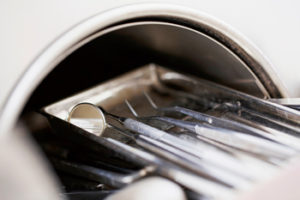By Dr. Katherine Schrubbe, RDH, BS, MEd, PhD.

Quality assurance processes and procedures are inherent to the infrastructure of DSOs and large group practices.
Quality assurance measures provide the basis for sound protocols that meet the standard of care for patient treatment, as well as compliance to stated guidelines and recommendations outlined by important agencies, such as the Centers for Disease Control and Prevention (CDC) and professional organizations, such as the American Dental Association (ADA), the Association for the Advancement of Medical Instrumentation (AAMI) and the Organization for Safety, Asepsis and Prevention (OSAP).
The correct reprocessing of reusable dental instruments in any practice setting is the foundation for patient safety. It’s important to monitor this process to ensure certain parameters are met during sterilization and to directly challenge the sterilizer in killing spores. As part of the quality assurance program, the practice should comply with CDC guidelines, which recommend three types of sterilization monitoring to ensure reusable dental instruments are safe for patient use1-3:
- Mechanical
- Chemical
- Biological
Mechanical monitoring
Mechanical techniques for monitoring involve evaluating the cycle times and temperature – or pressure – that is reached in the sterilizer by actually viewing the gauges or displays on the machine. Many newer models of sterilizers have computerized recording type devices, such as flash-drives, which can provide printouts of stored information related to mechanical monitoring. Dental team members should know the correct readings for all sterilizers so that inconsistencies are easily recognized and addressed.
Mechanical monitoring does not confirm sterilization; however, incorrect readings can be a first clue for sterilizer malfunction.1-3 Dental team members must remember that mechanical monitoring has to do with the processes occurring inside the sterilizer chamber, rather than the conditions of the packages, pouches or cassettes. Thus, mechanical monitoring will not detect problems that result from overloaded sterilizers, improper packaging materials or the use of closed containers.4
Chemical monitoring
 Chemical monitoring should be implemented on a routine basis. The goal of chemical monitoring is to determine whether instrument packages – including the instruments inside these packages – have been exposed to the sterilizing conditions.4 Chemical indicators (CIs) change color or physical form when a certain parameter is reached inside the sterilizer. Heat- or chemical-sensitive inks in the indicators change color when one or more sterilization parameter (e.g., steam-time, temperature, and/or saturated steam; ETO-time, temperature, relative humidity and/or ETO concentration) is present.3 Chemical indicators are available in different designs, including tape, strips and special markings on packaging pouches.
Chemical monitoring should be implemented on a routine basis. The goal of chemical monitoring is to determine whether instrument packages – including the instruments inside these packages – have been exposed to the sterilizing conditions.4 Chemical indicators (CIs) change color or physical form when a certain parameter is reached inside the sterilizer. Heat- or chemical-sensitive inks in the indicators change color when one or more sterilization parameter (e.g., steam-time, temperature, and/or saturated steam; ETO-time, temperature, relative humidity and/or ETO concentration) is present.3 Chemical indicators are available in different designs, including tape, strips and special markings on packaging pouches.
The CDC states, “a chemical indicator should be used inside every package to verify that the sterilizing agent (e.g., steam) has penetrated the package and reached the instruments inside. If the internal chemical indicator is not visible from the outside of the package, an external indicator should also be used. External indicators can be inspected immediately when removing packages from the sterilizer. If the appropriate color change did not occur, do not use the instruments. Chemical indicators also help to differentiate between processed and unprocessed items, eliminating the possibility of using instruments that have not been sterilized.”2 Chemical indicators should not replace biological indicators, as only a biological indicator consisting of bacterial endospores can measure the microbial killing power of the sterilization process.5
The AAMI offers the following table to explain the six types of chemical indicators.6 (It is important that all dental team members are trained on the chemical indicators being used in their dental practice.)
The AAMI Standards list six types of chemical indicators:
| Type | Indications for Use |
| Type 1 | Process indicator for use on the exterior of packages. |
| Type 2 | For use in specific test procedures, i.e. Bowie-Dick type test to check for proper air removal of pre-vacuum steam sterilizers. |
| Type 3 | Single-variable indicator that reacts to one critical variable, i.e. time or temperature. |
| Type 4 | Multi-variable indicator that reacts to 2 or more critical variables. |
| Type 5 | Integrating indicator that reacts to all critical variables and is equal in performance to a biological indicator, but does not replace routine biologic monitoring. |
| Type 6 | Emulating indicator that reacts to all critical variables for a specified sterilization cycle. |
ANSI/AAMI ST79:2010/A4:2013 Comprehensive guide to steam sterilization and sterility assurance in health care facilities – http://www.aami.org/productspublications/ProductDetail.aspx?ItemNumber=1383
Many dental professionals and staff are familiar with autoclave tape from dental school or their training programs. Autoclave tape is often used on the external packaging of wrapped cassettes or instrument packs. The tape is considered a Class 1 chemical indicator and usually reacts to one variable: temperature/heat. Using only a Class 1 tape chemical indicator on the external packaging does not meet the full requirements for chemical indicator protocols established by the CDC.1-3 Also, this type of external chemical indicator does not indicate that sterilization – let alone a complete sterilization cycle – has occurred. For instance, it’s possible the sterilizer reached the appropriate temperature and then immediately malfunctioned after the chemical indicator already changed color.4
In addition to the Class 1 chemical indicators, other types of chemical indicators commonly used include the multiparameter CI, which may be a Class 4 that reacts to more than one parameter (time, temperature or the presence of steam), and the integrating CI, which is a Class 5 that reacts to all three parameters. Many manufacturers make dual-indicator pouches, which have both internal and external Class 4 CIs built into the packaging, meeting the criteria set by the CDC. Integrating chemical indicators in the form of strips should be used for cassettes and are available through a variety of vendors. Integrating indicators should be placed inside the cassette prior to placing it in a large pouch or wrapping. After opening each processed pack, pouch or cassette, the dental team must immediately observe the internal chemical indicator. If the appropriate change has not occurred, the sterilizing agent has not penetrated the packaging material or the package has not been processed through the sterilizer,4 and the items should not be used on a patient.
Biological monitoring
Sterilizer monitoring – together with the proper sterilization of instruments and materials – is an essential part of any in-office infection control program,5 according to the ADA. Biological indicators (BIs), or spore tests, are the only process indicators that directly monitor the lethality of a given sterilization process. Spores used to monitor a sterilization process have demonstrated resistance to the sterilizing agent and are more resistant than the bioburden found on medical devices. B. atrophaeus spores are used to monitor ETO and dry heat, and G. stearothermophilus spores are used to monitor steam sterilization, hydrogen peroxide gas plasma and liquid peracetic acid sterilizers.3
Biological monitoring should be completed on a weekly basis1-5 and results should be logged. Maintaining accurate records ensures cycle parameters have been met and establishes accountability in the practice.2 Dental team members responsible for conducting weekly spore testing must be trained and take their responsibility seriously. Many larger practices and DSOs have dedicated sterilization staff to carry out these duties, which helps to ensure consistency and calibration that positively impacts patient safety.
Instructions for use (IFU) should be followed for the specific biological indicator used in the practice, and both the control and test biological indicator must be from the same lot number. Miller outlines the general procedure for use of biological indicators:4
- Insert the biological indicator inside a pack, pouch or cassette and complete the packaging procedures.
- Place the pack, pouch or cassette in the center of the load (unless otherwise indicated by the sterilizer IFU) and process as part of a normal load cycle.
- Record the date of the test, type of sterilizer, temperature and time of the cycle, nature of the packaging and name/initials of the staff member conducting the spore test.
- Retrieve the test biological indicator and mail it with the control biological indicator to the monitoring service, or follow the protocol for in-office incubation of the biological indicators.
- Receive/maintain records of the results.
Biological monitoring should also be completed:6
- When running the first cycle after a repair to a sterilizer. (Release the load only after a passing biological indicator. AAMI recommends attaining three passing biological indicators before putting the sterilizer back into service.)
- On all implantable devices. (This is not applicable for most dental settings, as implants are delivered sterile by the manufacturer.)
- At the initial use of a sterilizer.
- During the training of new staff.
- When a loading procedure has changed.
- When processing hazardous waste on-site.
Dental practices may question how long they should maintain sterilization records. The CDC recommends that practices maintain sterilization records for three years, but it stresses the importance of researching any local or state regulations that may apply.3
The three types of sterilization monitoring all play an important role in the quality assurance program of the practice. Dental team members must have a clear understanding of these procedures and a rationale to carry out these tasks, which highly impact patient safety. It is important in all practice settings to ensure the correct staff members are placed in the correct areas of the practice and that they are well trained. DSOs and large group practices in particular can serve as models for demonstrating the commitment to best practices in sterilization monitoring and compliance to guidelines for safe patient care.
References
- Centers for Disease Control and Prevention. Guidelines for Infection Control in Dental Health-Care Settings – 2003. MMWR 2003;52(No. RR-17); 24-25.
- Centers for Disease Control and Prevention. Summary of Infection Prevention Practices in Dental Settings: Basic Expectations for Safe Care. Atlanta, GA: US Department of Health and Human Services, Centers for Disease Control and Prevention, National Center for Chronic Disease Prevention and Health Promotion, Division of Oral Health, March 2016.
- Centers for Disease Control and Prevention. Guideline for Disinfection and Sterilization in Healthcare Facilities (2008); last update: February 15, 2017. Available at: https://www.cdc.gov/infectioncontrol/pdf/guidelines/disinfection-guidelines.pdf. Accessed March 11, 2018.
- Miller CH, Palenik CJ. Infection Control and Management of Hazardous Materials for the Dental Team. 5th ed. St. Louis: Mosby Elsevier; 2013; 135-141.
- American Dental Association. Oral health topics – infection control. Available at: https://www.ada.org/en/member-center/oral-health-topics/infection-control-resources. Accessed March 11, 2018.
- Organization for Safety, Asepsis and Prevention. OSHA and CDC Guidelines; Combining safety with infection control and prevention for Dentistry. Interact Training System; 5th Ed, 2017.
Editor’s note: Dr. Katherine Schrubbe, RDH, BS, M.Ed, PhD, is an independent consultant with expertise in OSHA, dental infection control, quality assurance and risk management. She is an invited speaker for continuing education and training programs for local and national dental organizations, schools of dentistry and private dental groups. She has held positions in corporate as well as academic dentistry and continues to contribute to the scientific literature.

